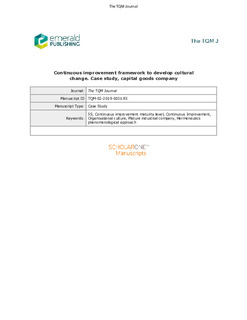Title
Continuous improvement framework to develop cultural change: case study, capital goods companyVersion
Postprint
Rights
© 2020, Emerald Publishing LimitedAccess
Open accessPublisher’s version
https://doi.org/10.1108/TQM-02-2019-0051Published at
The TQM Journal Publication date: 7 May 2020Publisher
Emerald Publishing LimitedKeywords
5S
Continuous improvement maturity level
Continuous improvement
Organisational culture ... [+]
Continuous improvement maturity level
Continuous improvement
Organisational culture ... [+]
5S
Continuous improvement maturity level
Continuous improvement
Organisational culture
Mature industrial company
Hermeneutic phenomenological approach [-]
Continuous improvement maturity level
Continuous improvement
Organisational culture
Mature industrial company
Hermeneutic phenomenological approach [-]
Abstract
In this study, a frame of reference was developed to adapt and execute a continuous improvement process (CIP) for reinforcing a continuous improvement (CI) culture in an organisation. The study was un ... [+]
In this study, a frame of reference was developed to adapt and execute a continuous improvement process (CIP) for reinforcing a continuous improvement (CI) culture in an organisation. The study was undertaken in a mature capital goods company that did not succeed in institutionalising CI despite deploying many CI tools over the years. The organisation thus needed a model that was adapted to its reality and strengthened the aspects of CI through cultural changes at the organisational level.
Action research was used to implement the CIP, and this research method was reinforced using a hermeneutic phenomenological approach to analyse the results.
The CIP was validated in four units of analysis within the organisation. For the validation, aspects relevant to organisational cultural change and their metrics were identified. The results showed that the main barriers to the development of CI in the case organisation were lack of teamwork and poor assimilation of new CI routines.
The study was applied only in one organisation. Therefore, results cannot be generalized, although the process and methodology followed to adapt and implement the CIP could be applied within other organisations
The paper presents a CI frame of reference and describes how a CIP applied to a small and medium-sized industrial enterprise generated cultural changes and promoted organisational excellence in the pursuit of CI by using a hermeneutic phenomenological methodology approach. [-]
Collections
- Articles - Engineering [728]
The following license files are associated with this item:






















